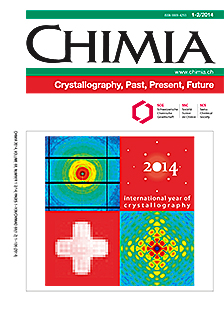Biocrystallography in Switzerland: Achievements and Future Perspectives
DOI:
https://doi.org/10.2533/chimia.2014.54Keywords:
Protein crystallographyAbstract
The first protein crystallography group in Switzerland was installed at the Biozentrum of the University of Basel approximately 40 years ago. Since then protein crystallography has grown and matured remarkably and is now established in the molecular biology, biochemistry or biological medicine departments of most major Swiss Universities as well as in the pharmaceutical industry and in biotech startup companies. Swiss X-ray biocrystallography groups have made remarkable contributions from the beginning and have brought Switzerland to the forefront in biostructural research during the last 5 to 10 years. Switzerland has now a leading position in the areas of supramolecular complexes, membrane proteins and structure-based drug design in pharmaceutical and biotech industries. Protein crystallography on the outer membrane protein ompF as well as the development of the lipidic cubic phase crystallization methodology has been pioneered at the Biozentrum. The latter found its somewhat late recognition through the recent explosion in structure determinations of the seven transmembrane helix G-coupled receptors. Highlights from Swiss structural biology groups in the field of supramolecular complexes include the structures of ribosomal particles, of the nucleosome and the pilus assembly complex of uropathogenic E. coli. On the membrane protein side advances in the field of ABC transporters and ion channels are world-recognized achievements of Swiss structural biology. Dedicated laboratories at many academic and industrial institutions, their current research programs, the availability of excellent infrastructure and the continuing efforts to build new facilities such as the SwissFEL indicate an even brighter future for structural biology in Switzerland.Downloads
Published
2014-02-26
Issue
Section
Scientific Articles
License
Copyright (c) 2014 Swiss Chemical Society

This work is licensed under a Creative Commons Attribution-NonCommercial 4.0 International License.
How to Cite
[1]
Chimia 2014, 68, 54, DOI: 10.2533/chimia.2014.54.







